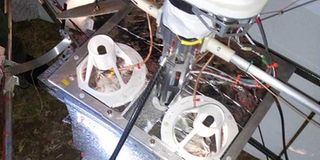Google internet balloon causes scare as it crashes in Meru

Google's Project Loon balloon that landed in a miraa farm in Nthambiro, Igembe Central in Meru County on December 29, 2017 causing a scare. Project Loon launched 10 balloons in Kenya this year for testing. PHOTO | DAVID MUCHUI | NATION MEDIA GROUP
What you need to know:
Some scared residents expressed concern after they complained of headache after approaching the device.
Loon balloons act as floating cell phone towers, allowing local telecommunications companies to extend their coverage.
The device is made of two main radio transceivers on each balloon which can provide coverage to an area of about 80km in diameter.
A Google high altitude balloon meant to provide high speed internet in Kenya crashed at Nthambiro in Meru Friday night causing a scare among residents.
Residents gathered in a miraa farm where the balloon powered device fell to get a glimpse of it before police officers took it away.
The device from Google’s balloon-powered high-speed internet service known as Project Loon is part of 10 balloons deployed in July 2017 for testing in Nakuru, Nanyuki, Nyeri and Marsabit.
Some scared residents expressed concern after they complained of headache after approaching the device.
Igembe South OCPD Jane Nyakeruma said no injuries or damages were reported as a result of the crash.
“The device from Project Loon indicates it fell after its expiry period of six months. No one is yet to claim the device,” Ms Nyakeruma said.
SUPER PRESSURED
According to the developer, Project Loon is a global network of high altitude balloons which ascend like weather balloons until they reach the stratosphere where they sail about 20 km (65,000 feet) above the earth.
“The Loon balloons are super pressured, allowing them to last much longer. Loon balloons are also unique in that they can sail the wind to travel where they need to go. They can coordinate with other balloons as a flock and their electronics are entirely solar powered,” it states.
Loon balloons act as floating cell phone towers, allowing local telecommunications companies to extend their coverage into areas that are unserved and hence providing 4G internet.
The device is made of two main radio transceivers on each balloon which can provide coverage to an area of about 80km in diameter.
Project Loon has been used to provide emergency mobile network coverage to Puerto Rico following the hurricane Maria disaster.
It was first launched in 2012 with the aim of providing internet in remote areas of the world.





